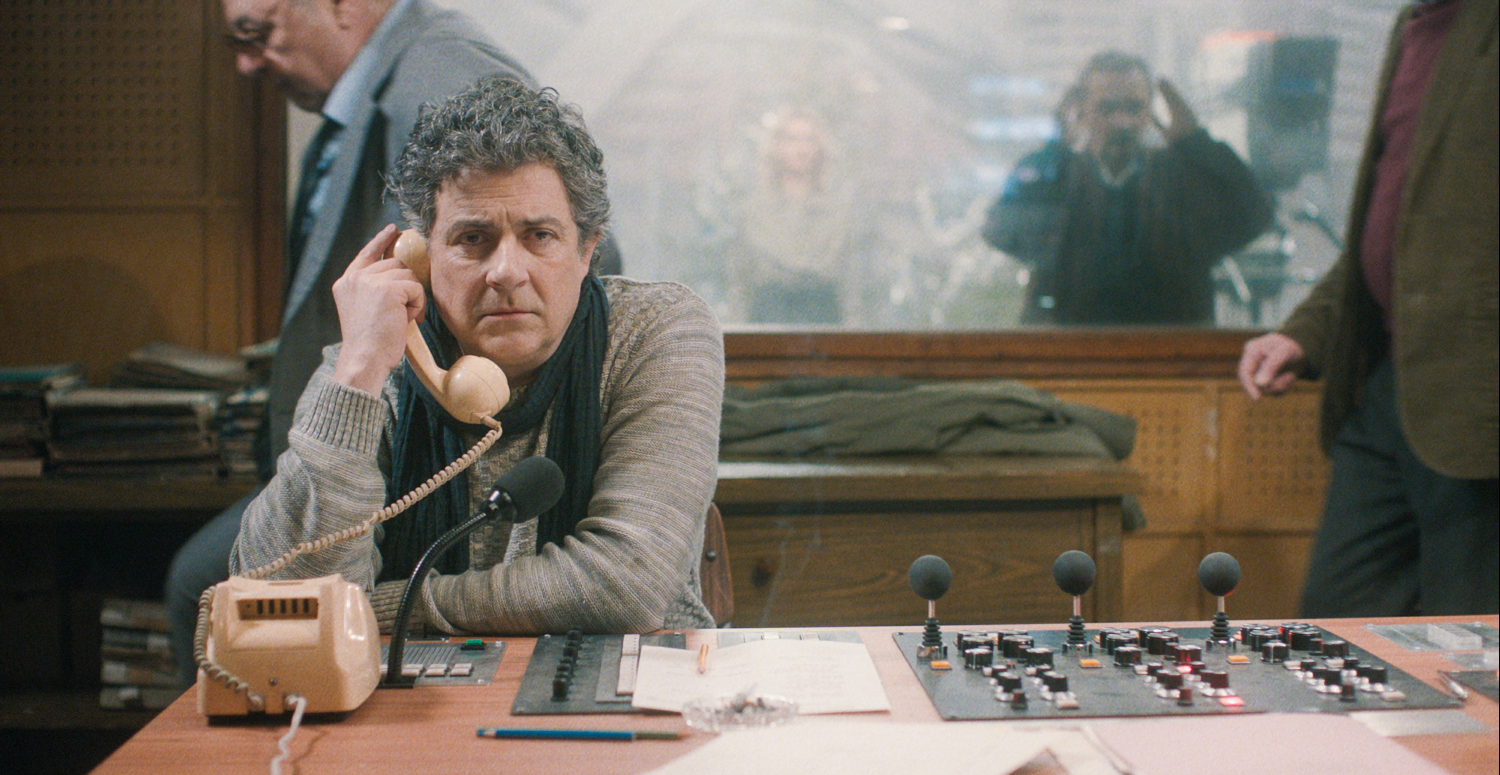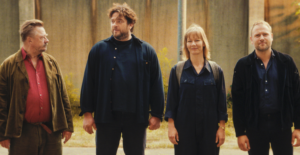Ce nouvel an qui n’est jamais arrivé
Anul Nou care n-a fost
Prix Orizzonti – Venise
Golden Pyramid – Cairo
Best Film & Best First Film – Romania
Best Director & Best Screenplay – Romania
Best Lead Actor & Lead Actress – Romania
Best Editing & Production Design – Romania
Best Sound & Make and Hairstyling – Romania
2024/2025

FR EN
Le 9 novembre 1989 le Mur de Berlin chute. En Roumanie, aucune mention n’est faite de l’événement dans la presse ou la télévision d’État. Un mois plus tard, la dernière ‘démocratie populaire’ dirigée depuis quinze ans d’une main de fer par un dictateur communiste, Nicolae Ceauşescu, s’apprête à basculer lors d’un banal discours de son ‘Conducator’ devant la foule venue l’acclamer … Nous sommes le 20 décembre, à quelques jours de Noël, suite au massacre étudiant de Timisoara, le pays est au bord de l’implosion. Mais les autorités préparent les festivités du Nouvel An comme si de rien n’était !
C’est dans ce contexte littéralement extraordinaire, que le scénariste et réalisateur Bogdan Mureşanu nous emmène auprès de personnages tout à fait ordinaires : un étudiant, un apparatchik, une famille en panique, et une improbable équipe de télévision. Tous l’ignorent, mais le régime va s’effondrer le lendemain dans ce qui restera comme l’une des révolutions les plus rapides de l’Histoire. Si cette fin de règne éclair a déjà été racontée dans le cinéma roumain, son approche tisse une fresque unique en forme de kaléidoscope le temps d’une journée au gré d’une narration fragmentée qui parvient néanmoins à garder l’ensemble cohérent grâce à une excellente construction au scénario et au montage (avec deux monteurs différents pour ajuster cette structure narrative).
Si le résultat final est certes un peu long (2h18), force est de constater qu’il n’y a pas une scène en trop dans ce récit sans temps mort, d’abord un peu déroutant, mais dont l’accumulation des micro-événements nous achemine vers un bouleversement général. Tout est admirablement relié à travers des trajectoires qui se croisent et s’effleurent de manière parfois dramatique, parfois fortuite, mais toujours en parallèle. Pourtant connectés entre eux, les personnages ne se connaissent donc pas, ne se parlent pas, et finalement n’habitent pas les mêmes intrigues, chacun vit ainsi dans son propre petit monde. Car dans une dictature, la peur et le soupçon transforment une société en un archipel d’îles fermées. Les citoyens s’habituent au double langage, à chuchoter, à marcher sur des œufs.

Or, bien que le film distille bel et bien cette atmosphère paranoïaque dans laquelle se débattait la société roumaine, il délivre avant tout une note joyeuse et euphorique. C’est finalement et étonnamment plutôt un ‘feel good movie’ ce qui implique de terminer le récit au moment où tout est parfait pour l’ensemble de ces personnages pourtant dépassés par les événements. Le film ne montre alors pas véritablement la révolution en elle-même, laissant les violences qui s’ensuivirent à la grande Histoire. Ce n’est en ce sens moins un film historique, qu’une fresque tragicomique sur une galerie de personnages ordinaires. Et ce choix de la tragicomédie reflète tout le concept narratif d’un film où les spectateurs savent ce que les personnages ignorent : les uns vivent dans un monde de peur, de désespoir, dans une prison, sans savoir qu’une issue se présentera le lendemain ; quand pour les autres qui savent que le régime s’apprête à tomber et que le couple Ceauşescu sera exécuté sans délai le 25 décembre, cela rend follement absurde et comique les comportements des différents personnages.
« Ce nouvel an qui n’est jamais arrivé » est un premier film particulièrement réussi, porté par de superbes interprètes dans un tempo plutôt lent et progressivement crescendo – à l’image du « Boléro » de Ravel utilisé dans la séquence finale – et au titre intrigant qui fait référence à cette émission télé qui ironiquement n’a jamais été diffusée et s’apparentait à un ultime soubresaut kafkaïen d’un régime à l’agonie. La caméra à l’épaule renforce par ailleurs la dimension quasi-documentaire du récit quand le format 4 :3 traduit l’enfermement des personnages et du pays avant de s’élargir en 16 :9 comme une métaphore de la liberté qui voit le jour dans un final mêlant images d’archives et de fiction alors que l’étincelle de la révolution est allumée …
Raphaël Sallenave
On November 9, 1989, the Berlin Wall fell. In Romania, no mention was made of the event in the press or on state television. One month later, the last ‘people’s democracy’ ruled with an iron fist by a Communist dictator, Nicolae Ceauşescu, for fifteen years, was about to topple during a banal speech by its ‘Conducator’ to the cheering crowds… It was December 20, just a few days before Christmas, and following the student massacre in Timisoara, the country was on the brink of implosion. But the authorities are preparing the New Year festivities as if nothing had happened!
It’s against this literally extraordinary backdrop that writer-director Bogdan Mureşanu takes us on a journey of ordinary characters: a student, an apparatchik, a panicking family and an unusual TV crew. They all don’t know it, but the regime will collapse the next day in what will go down as one of the fastest revolutions in history. While this lightning end to the reign of power has already been told in Romanian cinema, his approach weaves a unique kaleidoscope-like tale over the course of a day, with a fragmented narrative that nonetheless manages to keep the whole coherent thanks to excellent storytelling and editing (with two different editors to fine-tune this narrative structure).
While the final result may be a little long (138’), there’s not a scene too many in this seamless narrative, which is initially a little confusing, but whose accumulation of micro-events leads to a general upheaval. Everything is admirably tied together through paths that cross and graze each other, sometimes dramatically, sometimes incidentally, but always simultaneously. Although connected, the characters don’t know each other, don’t talk to each other, and don’t share the same storylines, each living in their own little world. After all, in a dictatorship, fear and suspicion transform a society into an archipelago of closed islands. Citizens get used to hiding things, to whispering, to walking on eggshells.

And yet, although the film conveys the paranoid atmosphere in which Romanian society was struggling, it is above all joyful and exhilarating. Ultimately, and surprisingly, it’s more of a ‘feel good movie’, which means that the story ends when everything looks just perfect for all the characters, who are nonetheless overwhelmed by the situation. The film then doesn’t really show the revolution itself, leaving the subsequent violence to history. In this sense, it’s less a historical film than a tragicomic tale about a host of ordinary characters. And this choice of tragicomedy reflects the whole narrative concept of a film in which viewers know what the characters don’t: the former live in a world of fear and despair, in a prison, without knowing that there will be a way out the next day; while for the latter, who know that the regime is about to fall and that the Ceauşescu couple will be executed forthwith on December 25, this makes the behavior of the various characters wildly absurd and comic.
“The New Year That Never Came” is a particularly accomplished first feature, driven by superb performances in a rather slow tempo that gradually builds to a crescendo – like Ravel’s “Bolero” used in the final sequence – and an intriguing title that refers to the TV program that ironically was never broadcast, and was akin to the final Kafkaesque gasp of a dying regime. The handheld camera also reinforces the quasi-documentary dimension of the story, while the 4:3 aspect ratio conveys the imprisonment of the characters and the country, before expanding to a 16:9 ratio as a metaphor for the freedom that emerges in a finale combining archival and fictional images, when the spark of revolution is lit…
Raphaël Sallenave

